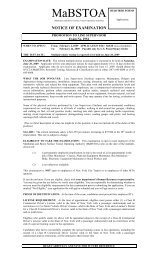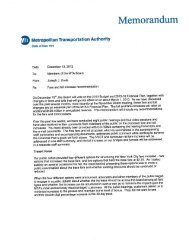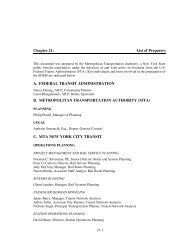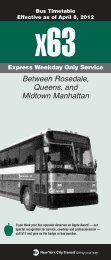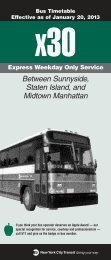Greening Mass Transit & Metro Regions: The Final Report - MTA
Greening Mass Transit & Metro Regions: The Final Report - MTA
Greening Mass Transit & Metro Regions: The Final Report - MTA
Create successful ePaper yourself
Turn your PDF publications into a flip-book with our unique Google optimized e-Paper software.
58<br />
BASELINE<br />
<strong>The</strong> Commission’s adaptation study indicates that storm protections, facility redesigns, and other adaptation policies are<br />
currently being carried forward in an ad hoc manner by the various <strong>MTA</strong> agencies. <strong>The</strong> <strong>MTA</strong> has yet to develop a unified<br />
climate adaptation plan and lacks staff with specific expertise in climate projections and analysis. However, many of the<br />
recommendations in this report, particularly in the areas of energy-efficient cooling systems and water management,<br />
clearly have added value in terms of adaptation. Since flooding due to SLR, coastal surges, and increased rainfall are the<br />
most significant risks from climate change, the <strong>MTA</strong>’s current storm policies will also be useful for adaptation programs.<br />
In addition, the <strong>MTA</strong> is participating in three related government task forces: the New York State Sea Level Rise Task Force,<br />
the NYSERDA-sponsored ClimAID Project Task Force, and the New York City Climate Change Adapation Task Force. <strong>The</strong><br />
<strong>MTA</strong> is also coordinating strategies with Con Edison and other major regional partners. This report recommends that the<br />
<strong>MTA</strong> develop a comprehensive Climate Change Master Plan by 2015. <strong>The</strong> plan should integrate ongoing climate forecasts,<br />
emergency response plans, a decision-making matrix, extensive mapping of system elevations and flood risks, evaluation of<br />
facilities design, climate-risk assessment for TOD programs and expansion projects, target elevations for new construction,<br />
assessment of <strong>MTA</strong> insurance programs, and other adaptive strategies. Clearly, such strategies must be integrated into <strong>MTA</strong><br />
Capital Programs and coordinated with other public and governmental entities from the local to state and federal levels.<br />
<strong>The</strong> <strong>MTA</strong> has undertaken a thorough review of systemwide storm vulnerabilities and policies in response to the storm<br />
of August 8, 2007 (see August 8, 2007 Storm <strong>Report</strong> published September 2008, at www.mta.info). Remedial measures<br />
are being implemented and scheduled through an internal tracking system. <strong>The</strong> storm report lists 17 major initiatives,<br />
with more than two dozen projects that fall into three major categories: operations, engineering, and communications.<br />
In operations, projects include the establishment of early warning and response capabilities, procedures, and teams; the<br />
creation of an <strong>MTA</strong> emergency response center (ERC); and a revision of the agency storm operating protocol. <strong>The</strong> engineering<br />
initiatives include corrective engineering and procedural measures at some of the most notorious flood-prone locations,<br />
often involving close cooperation with and capital expenditures by the New York City DEP and DOT. Communications<br />
initiatives include a contract to install wireless communication capabilities that will allow the use of cell phones in subway<br />
stations. Six subway stations are scheduled to be cell-operational by the end of 2010 and all 270 underground stations<br />
should be cell-accessible by 2014. In addition, personnel at Long Island Rail Road, <strong>Metro</strong>-North Railroad and Bridges and<br />
Tunnels were equipped with additional communications devices to ensure communication redundancy in emergencies. <strong>The</strong><br />
storm-response measures, combined with climate trend projections and the agency surveys, provide a useful starting point<br />
for the <strong>MTA</strong>’s first systemwide climate adaptation strategies.<br />
No. of Days > 90°F<br />
In New York City<br />
Days per year over 90°F<br />
80<br />
60<br />
40<br />
20<br />
0<br />
No. of Days > 100°F<br />
In New York City<br />
Historic Emissions Higher Emissions Lower Emissions<br />
Forecast of number of days/year in New York City with temperatures exceeding 90 0 F (left) and 100 0 F (right) for<br />
different decadal periods and for two GHG emissions scenarios. <strong>The</strong> orange bar represents observed occurrences prior to<br />
1990. (Source: NECIA, 2006)<br />
Days per year over 100°F<br />
0<br />
1961-1990 2010-2039 2040-2069 2070-2099 1961-1990 2010-2039 2040-2069 2070-2099<br />
80<br />
60<br />
40<br />
20<br />
<strong>MTA</strong> Subway Lines<br />
Lowest Critical Elevations(LCEs)<br />
A C Lines 7.0 feet<br />
M NR Lines 7.5 feet<br />
1 Line 9.1 feet<br />
2 3 Lines 9.1 feet<br />
4 5 6 Lines 9.9 feet<br />
E F Lines 10.0 feet<br />
B Q Lines 12.7 feet<br />
Elevations measured in feet above the National<br />
Geodetic Vertical Datum of 1929 – NGVD’29.<br />
Source: Jacob et al. (2000) 2<br />
2 Jacob, K.H., N. Edelblum, and J. Arnold (2000). Risk Increase to Infrastructure due to Sea Level Rise. Sector <strong>Report</strong>: Infrastructure for Climate Change and a Global City:<br />
An Assessment of the <strong>Metro</strong>politan East Coast (MEC) Region. 58 pp. & Data Appendices. http://metroeast_climate.ciesin.columbia.edu/reports/infrastructure.pdf.





